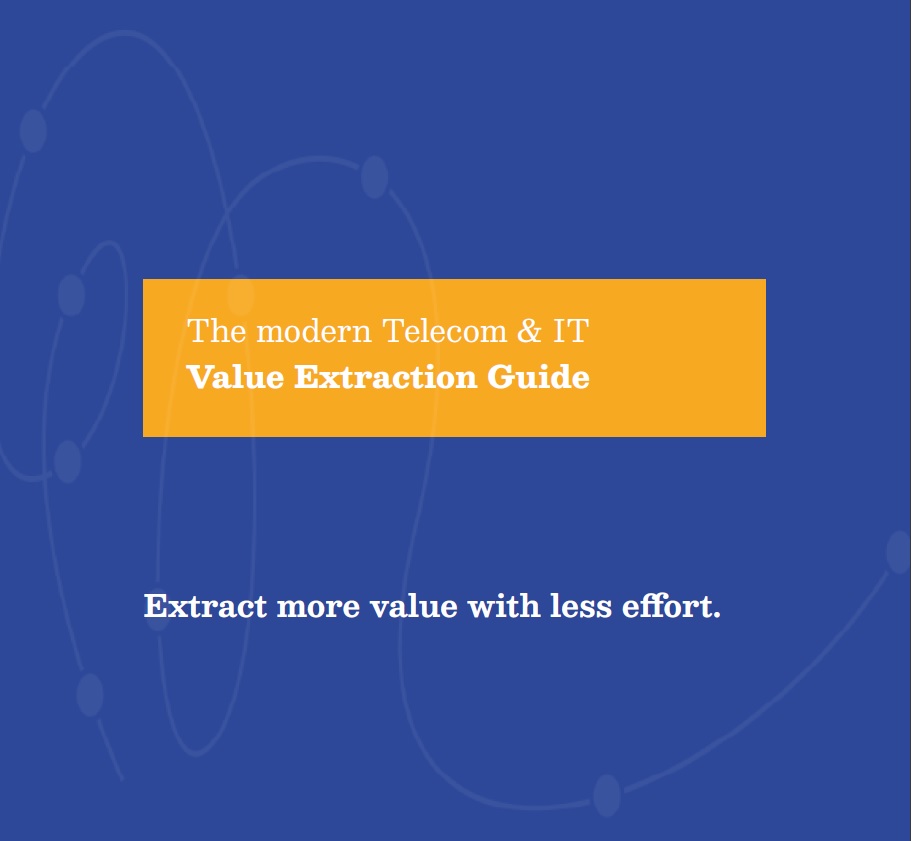Summary
Telecom, IT & Cloud make up 83% of global IT spend according to the worldwide IT spending report by Gartner. This is a massive number highlighting how significant these categories are to IT Procurement organizations.
Yet, despite the best efforts of IT Procurement to secure and sustain the best value for their business, they are almost guaranteed to be over-spending as much as 40% of their annual budgets on Telecom, IT & Cloud services. This figure is a symptom of a deeper problem of how difficult it is to obtain sufficient data to inform decision-making processes, align services with actual business needs, and break over-reliance on vendors to advise how to optimize the very services they are selling.
To reclaim lost value, enterprises need a solution working across three key pillars: Value Leakage, Billing Mistakes, and Contract Negotiations. A suitable solution must be continuous and consolidating data across every global region the business operates in. The traditional approach of undertaking annual cost saving reviews led by consultants are manual and do not effect lasting change.
We explore the key components of a modern value extraction solution and how to get started.
Telecom, IT & Cloud spend
Telecom, IT & Cloud are the largest drivers of global IT spend with increased spend reported each year. The figure below shows the breakdown of spend by each IT category.
These figures are important to highlight how significant these categories are to organizations. These categories are comprised of thousands of smaller, individual services that are shared across the organization and because of that, it’s often the case that the larger the organization is, the less visibility they have of what exact services they actually have and how much is being spent on them.
This reality poses a challenge to the business leader who wants to ensure the business got the “best deal” and is
sustaining the value. These services are critical to the business, and so making mistakes in procurement can impact operations.
For the leader who can successfully navigate this reality, there is the potential for them to save their organization millions without sacrificing service quality.

The Problem
IT Procurement leaders want to ensure their business sources the “best deal” and continues to sustain the value once the contract has been signed, but despite best efforts:

Optimization opportunities are left on the table because of insufficient data to improve your decision-making process about vendors and to identify and secure savings.

Services are not always aligned with actual business needs. For example, sourcing a great discount on 100 terabytes of data plan when you only need 5.

There's over-reliance on the vendor to advise how to optimize spend from the services they sold you, when their goals aren't necessarily aligned with yours.

The net result is of these problems is a persistent over-spend in the annual budgets for Telecom, IT & Cloud services.
How the Solution was Found
After living this hell for 10 years as an executive in the Telco industry, I had to find a better way!
As a keen data analyst, I researched ways to connect data from invoicing systems, networks, and contracts. Using that data, I kept iterating on building algorithms that could replace manual analyses.
Over a few years, these algorithms worked across billions in customer’s spend and thousands of enterprise contracts.
The results were transformative. Almost instantly, millions in revenue benefits were unlocked while simultaenously improving the customer experience for global enterprises.
Outside the Telco industry, it was obvious that enterprises were struggling with similar challenges. But there was a technical challenge to overcome – the data needed to run those algorithms were locked in documents like web pages, order forms, contracts, PDF invoices with thousands of pages. These documents come from different vendors, with their own jargon and written in different languages.
It became clear that in order for enterprises to reclaim lost value, they would first need connected data then algorithms working over that data. This insight led to the concepts and principles presented here and gave birth to Thinking Machine.
Reclaiming lost value
To reclaim lost value, enterprises need connected data and algorithms working across three key pillars: Value Leakage, Billing Mistakes, and Contract Negotiations.
Think of this as IT category management – on steroids!
These pillars achieve three key outcomes:
– Address value leakage in order to always pay the best price for what you need when you need it.
– Address billing mistakes in order to never let over-charging slip by ever again
– Address contract negotiations in order to know your services and contracts better than your lawyers and your vendors

5 Key Components of Value Extraction
Our three key pillars are made up of 5 components. These components organize the specific questions and resulting activities that extract value.

Let’s take a look at what each component aims to achieve.
1. What products are you paying for and what services do they provide?
2. Are those products including more services than you need?
3. Are you paying for additional products for services you never use?
—-
Examples:
Paying for 100 terabytes of data when you only need 5
Paying for premium fault restoration when your network doesn’t support it
Data Sources for Price List Selections:
Your Master Services Agreement (or equivalent) will contain pricing schedules that offer various prices for different services.
Invoices (in detailed form) will inform what products are active now, and will display the consumption for many of those products.
Cloud Billing APIs will inform what products cloud servers (Azure, AWS, GCP) have and how they are consumed.
1. How are services consumed on your network?
2. Are you still paying for services that aren’t live on your network anymore?
3. Are you paying for over-consumption from services being mis-used or abused?
—-
Examples:
Employees using their phones to call up the psychic hotline (at $3.99 a minute)
AWS servers switched off but still charging on the invoice
Data Sources for Service Utilization:
Invoices (in detailed form) will inform what services are active now, and will display the consumption for many of those services.
Cloud Billing APIs will inform what cloud servers (Azure, AWS, GCP) are active and how they are consumed.
Project Records come in various forms but we are looking for records of names of network sites, their current status, and dates when status changes occurred.
1. Who owns what on your network?
2. Are they the right owners?
3. Can we accurately identify all the right owners?
—-
Examples:
Paying for devices belonging to exited employees
Still paying for sensors at de-commissioned network sites
Data Sources for Service Ownership:
Invoices (in detailed form) will inform what services are active now and will often display the owning person or network code.
Cloud Billing APIs will inform what cloud servers (Azure, AWS, GCP) are active and who their owners are.
Cost Centre Records are records that represent how your organization is structured today (e.g. managers and their departments) and who should own what. These are often used for financial reconciliations and are also helpful for auditing Service Ownership.
1. Does our invoices contain the right prices and discounts?
2. Was each of our orders fulfilled correctly?
3. Did pricing changes happen at the right date?
—-
Examples:
New contract pricing showing up on invoices 3 weeks later than you signed for
Key discounts falling off halfway through the contract
Data Sources for Billing Mistakes:
Invoices (in detailed form) will inform what prices products and services were charged at in the past.
Cloud Billing APIs will inform what prices cloud servers (Azure, AWS, GCP) were charged at in the past.
Contract Documents can include your Master Services Agreement (or equivalent), Contract Variations, even Order Forms or Pro-Formas that were issued prior to updates being made to your services. These will inform the prices and discounts and at what date they were to be charged.
1. How do individual contract terms translate to real spend?
2. How much can we expect to be using our services in the next 3 years?
3. How much better is one vendor’s proposal against the others?
—-
Examples:
A minor $0.02 calling rate translates to a 2x increase in spend
Calculating the true “total cost of ownership” between vendors
Data Sources for Contract Negotiations:
Invoices (in detailed form) & Cloud Billing APIs will inform past consumption trends and how expensive products and services were.
Tender Submissions from prospective vendors & your existing Master Services Agreement (or equivalent) will provide a basis for cost evaluations.
Market Benchmarking provides guidance to understanding current market trends.
Bonus Tips
Many initiatives fail because the right documentation is hard to source. Even when companies have contract management systems in place, rarely is every relevant document stored. For example, when every Pro-Forma contains contractual pricing information, there can be hundreds of these documents that live in the inboxes of project managers. This creates friction when analyzing contracts because of the numerous inconsistencies that arise.
Here are some tips to help you think outside the box!

1. Can’t find clear records about old telephones? Physically dialling those services adds a useful data point
2. Spotting duplicate records of employee names on invoices helps focus attention
3. Turning up invoiced charges that don’t match with your contract prompts your vendor to find the missing contracts
Although no-one ever knows where to find everything, all the information you need is available to you if you know how to look for it.
Want to Extract the Greatest Value from your Services?
Our AI platform provides the connected data and the algorithms to automate the hardest tasks of auditing and optimizing Telco, IT & Cloud spend.
1. We maintain a live database of vendor pricing & benchmarking
2. We automatically extract and connect data from your unstructured documents (Contracts, Invoices, Order Forms etc.)
3. We fine-tune algorithms to understand your business objectives
4. We package up opportunities and data insights to save you time on reviewing analytics to negotiate better deals in the future
5. We help you secure and sustain savings with ongoing monitoring of your invoices against your contracts


